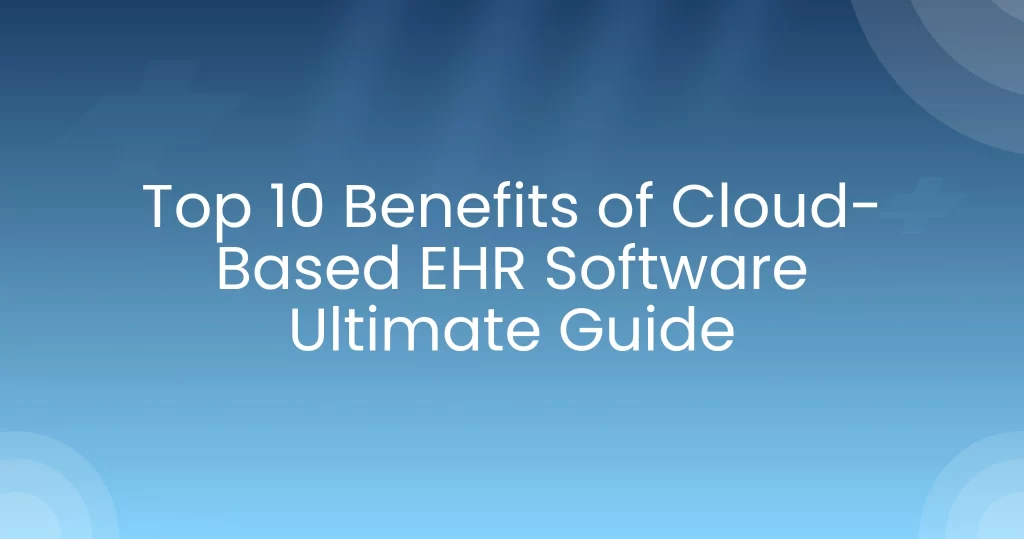
Electronic Health Records (EHR), the backbone of modern healthcare, have seen significant advancements in their management and delivery.
An increasing number of healthcare organizations are opting for cloud-based EHR software over client-server systems that demand expensive hardware and IT maintenance.
The shift to cloud-based EHRs is fueled by the need for interoperability, mobility, cost savings, and improved patient care. Providers find that cloud-based EHRs lighten administrative work while opening doors to telehealth, mobile access, and AI-powered support in small clinics or large hospitals.
In this 2025 guide, we’ll discover more than 10 key benefits of cloud-based EHR and compare it back-to-back with the traditional client-server model. We’ll also explain why it is becoming the best choice for healthcare providers of all sizes. .
What is Cloud-Based EHR Software?
A cloud EHR system is a computerized patient care record that can be shared digitally between multiple office locations, with data stored securely on remote servers.
With this, providers can access the system anytime, anywhere, from virtually any device with an internet connection. That spares them from having to keep up expensive on-site servers.
Cloud vs. Client-Server EHR: Key Differences
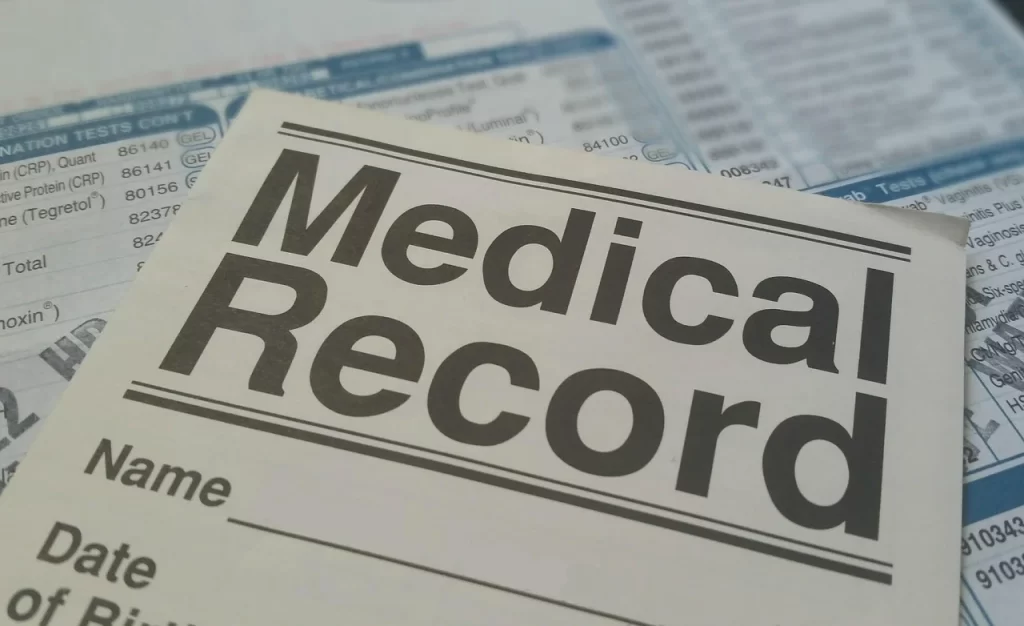
Traditional client-server EHR systems are hosted locally within a healthcare facility. These entail substantial investment in expensive hardware, continual IT administration, and unwavering attention to maintenance.
Cloud-based EHRs, however, are managed (support & updates) by EHR vendors on a subscription basis and will be updated automatically, which brings cost-effectiveness and scalability.
Cloud EHR systems enable healthcare employees to spend more time on treating patients than managing software.
Here’s a quick comparison:
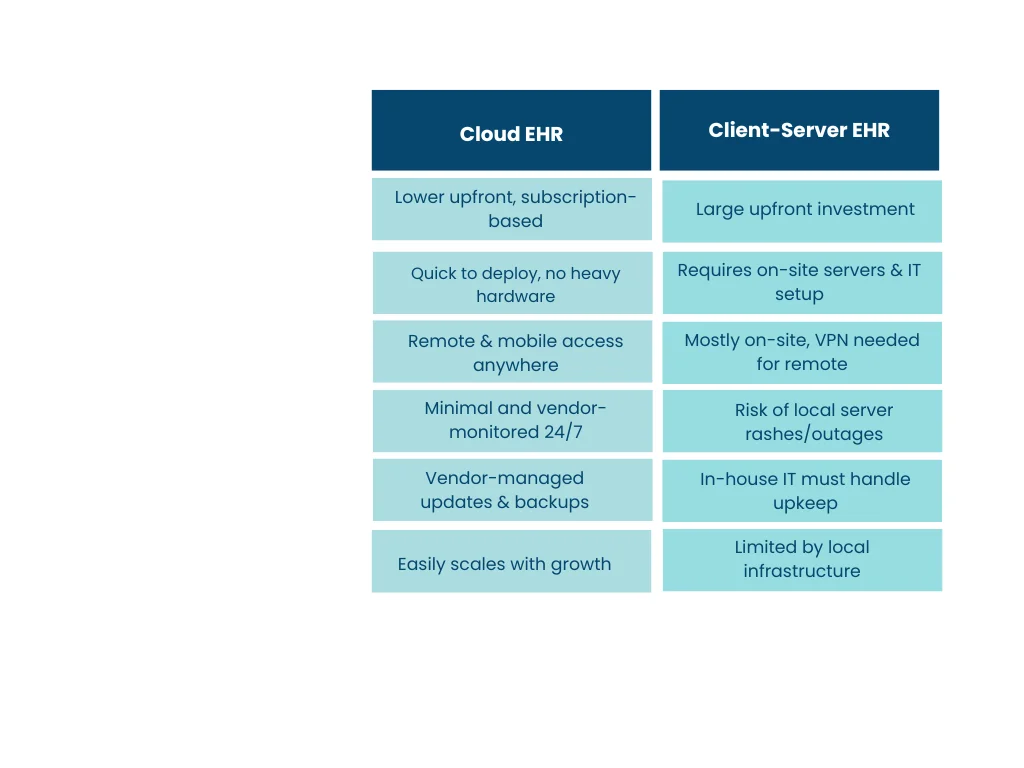
Top 10+ Benefits of Cloud-Based EHR Software in 2025

1. Cost Efficiency and Resource Reduction
Switching to a cloud-based EHR can save a lot of money. Instead of spending on expensive servers and constant maintenance, clinics can run their systems through a third-party service.
For example, a study at the University of Michigan School of Dentistry found that moving from an on-site EHR to a cloud-based system cut setup costs by about 40% and ongoing costs by roughly 20% over two years
This is especially helpful for smaller clinics, which can save significantly on IT expenses. Bigger organizations also benefit, since they don’t need to invest millions in servers and hardware.
Overall, cloud-based EHRs reduce the hassle of managing hardware, letting healthcare staff focus more on patients and less on IT.
Key Advantages:
- No Expensive Equipment or Server Rooms – Providers don’t need to invest in or maintain physical infrastructure.
- Reduced IT Staffing Needs – Vendors handle security, patches, and updates, keeping clinics and hospitals free from handling constant tech issues in-house.
- Pay-As-You-Go Model – Flexible subscriptions improve planning and cost management for small practices and big hospital networks.
2. Enhanced Accessibility and Mobility
One of cloud EHR’s most significant benefits is that they let users access records from anywhere. Providers aren’t tied to a single computer or office.
Suppose a provider is giving a patient an online and an office visit. In both instances, the doctor can instantly access the person’s medical history, letting the doctor continue the visit more efficiently and effectively.
Key Advantages:
- Remote access from anywhere – Physicians and staff can log in securely from their devices. They can log in whether they’re at home, at satellite clinics, or even while making hospital rounds.
- Mobile-friendly platforms – Many Cloud EHR solutions offer dedicated apps or mobile-responsive portals that allow the provider to review patients’ charts, prescribe medication, and update notes on the go.
- Multi-location flexibility – Ideal for practices like multi-office or telehealth services since it ensures patient information stays consistent across all points of care.
3. Improved Security and Data Protection
Security is one of the top concerns for healthcare organizations, and Cloud EHR security and compliance are designed to meet the strictest standards.
Client-server systems that depend on in-house IT for protection, whereas cloud providers deliver enterprise-grade safeguards.
Key Advantages:
- Advanced encryption & MFA – Patient data is encrypted in transit and at rest; multi-factor authentication (MFA) adds another layer of security.
- Automatic, regular backups – With the cloud, continuous backup and redundancy eliminate the chance of losing data.
- Centralized, vendor-managed security – Providers get 24/7 monitoring, intrusion detection, and automatic security patching.
- Built-in HIPAA compliance – Cloud vendors adhere to HIPAA and other regulations to reduce cyber-attack risks.
4. Simplified Daily Operations
Cloud-based EHR systems made it easier for providers and staff to get through the day without constant roadblocks. By keeping records, schedules, and treatment details within easy reach, everyday tasks moved faster, and patient care stayed consistent.
It streamlines patient treatment and eliminates the bottlenecks that may otherwise be in the way.
Key Advantages:
- Automated updates – Your practice is automatically updated to the latest version of your software. Each new version of cloud-based EHR systems contributes to maintaining timely patient care.
- Interoperability across providers – Providers can share patient information with other specialists, labs, and pharmacies more easily with cloud-based EHR systems.
- Reduces administrative burden – EHR systems empower clinicians to focus more on patient care and less on paperwork.
5. Patient Engagement and Care Improvement
Cloud-based EHR software can strengthen provider-patient relationships by giving patients more visibility and control over their health information. As a result, overall satisfaction and outcomes improve for both patients and providers.
Key Advantages:
- Patient Portals – Patients’ access to secure log-in to view health records, schedule an appointment, ask for prescription refills, and message providers.
- Secure Messaging – Facilitates patient-care team communication to minimize avoidable visits and enhance follow-up care.
- Live Health Information – Gives providers real-time lab and imaging results, along with clinical notes, to provide better care at the time of care.
- Better Participation & Satisfaction – Involved patients are more likely to adhere to a treatment regimen to achieve better health outcomes.
6. Scalability and Flexibility
Cloud-based EHR solutions are scalable. Its stages develop with a practice’s needs, rather than the necessity for expensive updates to expand, as may be required by customer server EHR systems.
Think about a growing multi-site clinic that can easily onboard new providers and sites to the same EHR system. And no extra server installs or IT people.
Key Advantages:
- Easily Add Users or Storage – This is ideal for growing practices without requiring real IT redesigns.
- Flexible for All Practice Sizes – Cloud EHR scales easily without your practice experiencing any downtime, whether you have a solo practice or a large hospital.
7. Reduced IT Burden
Traditional client-server EHR systems require continued oversight by in-house IT staff to maintain servers, apply patches, and solve system problems. However, with cloud EHRs, the responsibility is transferred to the vendor.
Key Advantages:
- No Server Management – You have no hardware or server to continue to work on, and you don’t have to worry about failure or paying for servers to get time.
- Lower IT Staffing Needs – Vendors conduct system maintenance, patches, and upgrades.
- Fewer Disruptions – Automated tracking and the ability to fix problems before they affect usage minimize downtime for clinicians.
8. Disaster Recovery & Business Continuity
Healthcare data must be protected against everything from cyberattacks to natural disasters. Disaster recovery is built in with cloud-based EHR software.
Key Advantages:
- Automatic Cloud Backups – Patient records are stored with multiple backups that remain safe and accessible even if the clinics’ servers and hardware fail.
- Rapid Recovery – Cloud platforms ensure minimal downtime, which keeps patient care uninterrupted.
- Regulatory Compliance – Backup and recovery processes are aligned with HIPAA and industry standards.
9. Advanced Analytics and AI integration
Looking ahead to 2025, AI in cloud EHR systems is transforming how healthcare providers analyze data and make decisions. Leveraging analytics gives providers actionable insights that improve patient outcomes and operational efficiency.
We see heavyweight cloud EHR vendors embedding Machine learning algorithms directly into their platforms by 2025.
Key Advantages:
- Predictive Insights – Determine which patients (e.g., risk of readmissions, progression of chronic conditions) are at risk, before problems develop.
- AI-powered Clinical Decision Support – AI-powered support warns about drug interactions, diagnostic possibilities, and treatment options.
- Population Health Management – Pooling together patient data can help track population trends, improve care coordination, and support value-based models of care.
- Operational Efficiency – Dashboards with AI use predictive margins and scheduling to anticipate patient demand and eliminate bottlenecks.
10. Compliance and Regulatory Support
Healthcare standards are constantly changing, so it’s hard to keep up to date with old technology. Cloud-based EHR software keeps providers ahead of the curve by automatically changing to reflect new rules of standards.
For example, when the government introduced new mandates on interoperability, cloud vendors integrated the changes into their platforms without any disruption for their clients.
It saves providers the expensive custom upgrades.
Key Advantages:
- Automatic Compliance Updates – Cloud service providers update you automatically, so you don’t have to keep up with changing regulations by manually updating yourself.
- HIPAA Compliance By Design – Security and privacy highlighted from architecture.
- Government Program Support – Cloud EHRs Work with MIPS, MACRA, and value-based care programs, simplifying much of the reporting.
11. Better Collaboration Across Systems
In today’s healthcare, care becomes more involved as it depends on seamless cooperation among doctors, specialists, the lab, and the pharmacy. The use of cloud EHRs also facilitates seamless data sharing and helps to enable highly integrated care delivery models.
When prescription updates for a patient are automatically sent from the EHR to a pharmacy with which the patient is associated, transcription-based errors can be reduced, and medication safety can be improved.
Key Advantages:
- Interoperability for Cross-System Communication – Can be used for easier referrals and coordinated care.
- Direct Integrations – Laboratories and pharmacies in private use can be directly interfaced to the EHR, allowing no duplicate entries.
- Supports Value-based Care – Simple data sharing helps providers measure quality and improve outcomes.
12. Future-Proof Technology
Here’s the most blatant pro of cloud-based EHR: flexibility. Cloud systems are built for rapid technology adoption in healthcare, so new technologies can be supported without forcing providers to rip and replace infrastructure.
In 2025 and beyond, cloud EHR platforms will become hubs for connected health ecosystems. With this, real-time data from patients, devices, and providers converge to enable proactive, personalized medicine.
Key Advantages:
- Integration with IoT and Wearables – Cloud-based EHR systems can store information from gadgets like fitness trackers and heart monitors to provide personalized treatment.
- Remote Monitoring Support – Caregivers can keep track of chronically ill patients outside of routine appointments
- Ongoing Innovation – Vendors introducing AI tools, speech recognition, and complex analytics are not disruptive.
- Future-Readiness – It ensures that providers are ahead as digital health evolves.
Cloud-Based EHR for Different Practice Types
All healthcare organizations are not equal. Cloud-based EHR solutions are scaled to all types of practices and sizes.
Solo and Small Practices
- Low Upfront Costs – You don’t have to worry about servers and IT infrastructure; it’s already included.
- Mobility – Secure access to records from home, a satellite office, or when making house calls.
- Easy to Manage – Automatic upgrades and vendor support mean fewer IT headaches.
Large Practices & Hospital
- Scalability – Add users, storage, and clinic locations with ease.
- Interoperability – Share patient records across departments, specialists, and external providers.
- Advanced tools – It has built-in features such as AI analytics, population health management, and disaster recovery.
Specialty Practices
- Internal Medicine – Offers seamless lab and imaging integrations.
- Behavioral Health – Secure telehealth integration and patient engagement portals
- Pediatrics – Growth charts, immunization tracking, and family history sharing.
Cloud-Based EHR vs. Client-Server EHR Detailed Comparison
Choosing between the two systems is one of the most critical decisions for healthcare providers. Though client-server systems once dominated, cloud solutions are now the clear choice for 2025.
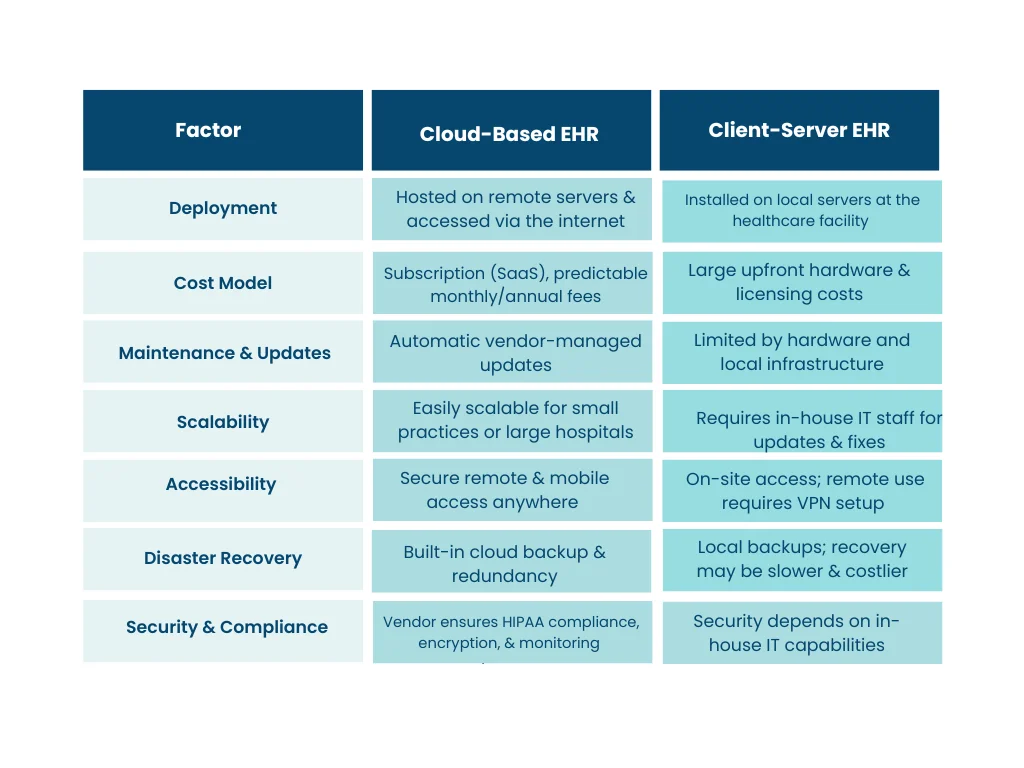
Real-World Examples & Statistics
Aside from being theoretical, the shift to cloud-based EHR solutions is backed by strong adoption trends across the healthcare industry.
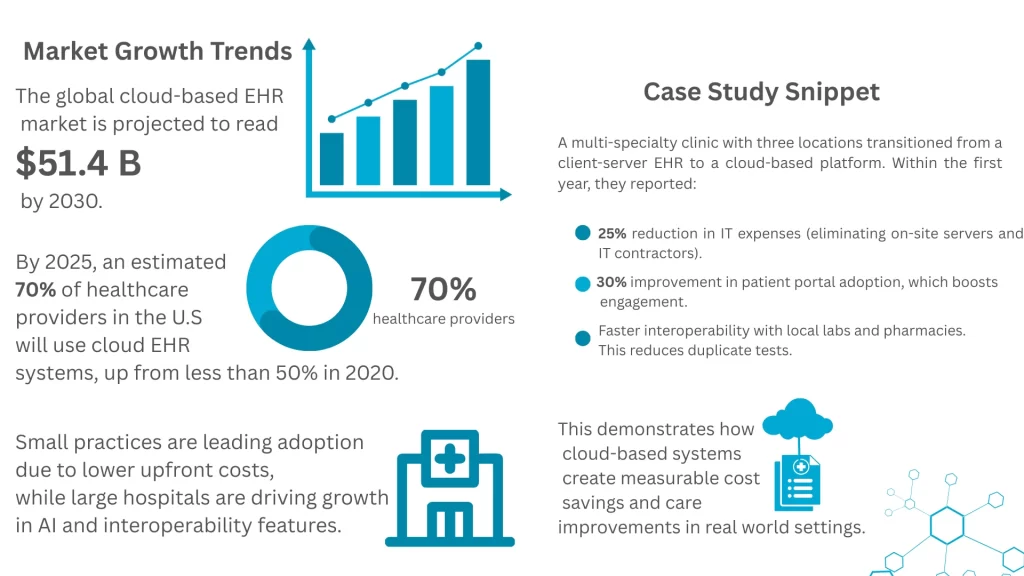
Key Stats on Cloud-Based EHR Adoption
- The global cloud-based EHR market is projected to reach about $51.4 billion by 2030, according to a forecast published in ScienceDirect.
- By 2025, around 70 percent of U.S. healthcare providers are expected to be using cloud-based EHR systems, up from less than half in 2020, based on projections shared by the Milbank Memorial Fund.
- Smaller practices are leading adoption because cloud solutions lower upfront costs, while larger hospitals are driving growth through investments in artificial intelligence and interoperability features, as noted by LifePoint Health.
- Clinics that have transitioned to cloud platforms reported about a 25 percent reduction in IT expenses after moving away from in-house servers, according to LifePoint Health case studies.
- Patient engagement also improves. One study highlighted on MoldStud showed a 30 percent increase in patient portal usage after switching to cloud-based systems.
- MoldStud also shared examples where providers saw duplicate lab and pharmacy tests drop by nearly 30 percent thanks to smoother data exchange.
Common Concerns About Cloud EHR
Although cloud EHR benefits are significant, healthcare leaders often have valid concerns. Let’s address the most common ones:
Is the cloud secure enough for patients’ data?
Yes. Leading cloud EHR vendors provide HIPAA-compliant encryption, multi factor authentication, and 24/7 monitoring, often exceeding the security of on-premise systems.
What about downtime and Internet dependency?
Cloud providers leveraged multiple data centers and failover devices to reach 99.9%+ uptime. Most applications will have an offline mode for local internet connection issues that syncs your progress as soon as you return online.
How does it affect staff training?
Client-server systems need a steeper learning curve compared to a Cloud platform. And most vendors offer role-based onboarding, training, and even around-the-clock support.
Conclusion
The significance of cloud-based EHR software has become apparent as we advance into 2025 and beyond, when healthcare evolves. From mobility costs, AI to compliance, future-proof scalability, and more, cloud hosting offers a competitive edge compared to old-guard, client-server offerings.
Cloud-based EHR systems enable the next wave of healthcare delivery by providing smarter security and simpler compliance, allowing providers and patients to be in the cloud.
If you’re considering an EHR upgrade, choosing a cloud-based solution ensures your practice stays secure, efficient, and future-ready.
FAQs
What are the main benefits of cloud-based EHR software?
Cloud-based EHR software offers cost savings, scalability, remote access, enhanced security, AI-powered analytics, and better interoperability than traditional client-server systems.
Is a cloud-based EHR HIPAA-compliant?
Top vendors design their systems with built-in HIPAA compliance, including encryption, secure access controls, and audit trails.
Can cloud-based EHR handle large hospital networks?
Absolutely. Cloud platforms are scalable, making them suitable for solo practices and large hospitals with multiple sites and thousands of users.
How does cloud-based EHR improve patient engagement?
Features like patient portals, secure messaging, appointment scheduling, and telehealth integration empower patients to stay engaged in their care.
What’s the difference between cloud-based and client-server EHR systems?
Cloud EHRs are in the cloud, with subscription pricing and automatic software upgrades, while client-server options are on-site with servers and higher upfront costs and manual upkeep.